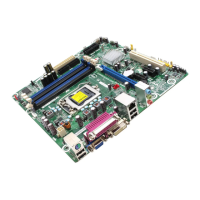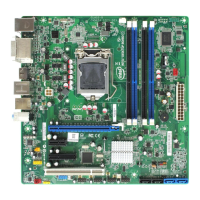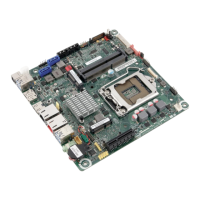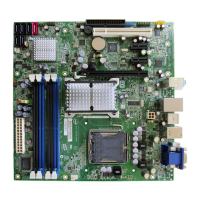Intel Desktop Board DQ45CB Technical Product Specification
22
1.6.3 Serial ATA Interfaces
The board provides five Serial ATA (SATA) connectors, which support one device per
connector. The board also provides one red-colored external Serial ATA (eSATA)
connector on the back panel.
1.6.3.1 Serial ATA Support
The board’s Serial ATA controller offers six independent Serial ATA ports with a
theoretical maximum transfer rate of 3 Gbits/sec per port. One device can be installed
on each port for a maximum of six Serial ATA devices. A point-to-point interface is
used for host to device connections, unlike Parallel ATA IDE which supports a
master/slave configuration and two devices per channel.
For compatibility, the underlying Serial ATA functionality is transparent to the
operating system. The Serial ATA controller can operate in both legacy and native
modes. In legacy mode, standard IDE I/O and IRQ resources are assigned (IRQ 14
and 15). In Native mode, standard PCI Conventional bus resource steering is used.
Native mode is the preferred mode for configurations using the Windows* XP and
Windows Vista operating systems.
NOTE
Many Serial ATA drives use new low-voltage power connectors and require adapters or
power supplies equipped with low-voltage power connectors.
For more information, see: http://www.serialata.org/
.
For information about Refer to
The location of the Serial ATA connectors Figure 10, page 50
1.6.3.2 Serial ATA RAID
The board supports the Intel® Matrix Storage Technology which provides the following
RAID (Redundant Array of Independent Drives) levels:
• RAID 0 - data striping
• RAID 1 - data mirroring
• RAID 0+1 (or RAID 10) - data striping and mirroring
• RAID 5 - distributed parity
1.6.3.3 Intel® Rapid Recover Technology
The board incorporates the Intel® Rapid Recover Technology (Intel® RRT). Intel®
Rapid Recover Technology is a feature of Intel® Matrix Storage Manager. It uses RAID
1 (mirroring) functionality to copy data from a designated master drive to a
designated recovery drive. The master drive data can be copied to the recovery drive
either continuously or on request.
When using the continuous update policy, changes made to the data on the master
drive while the recovery drive is disconnected or offline are automatically copied to the
recovery drive when it is reconnected. When using the on request update policy, the

